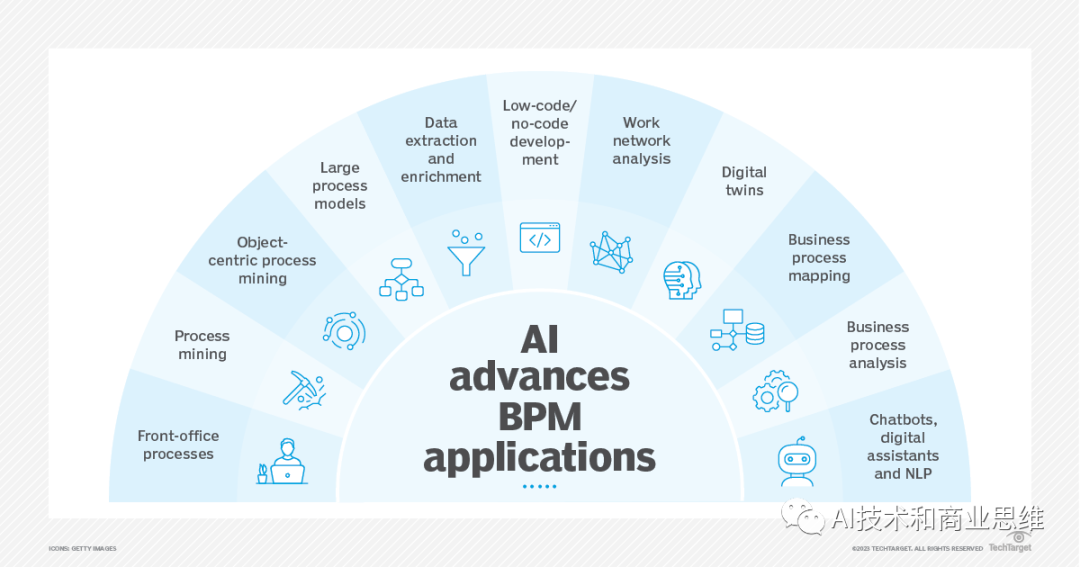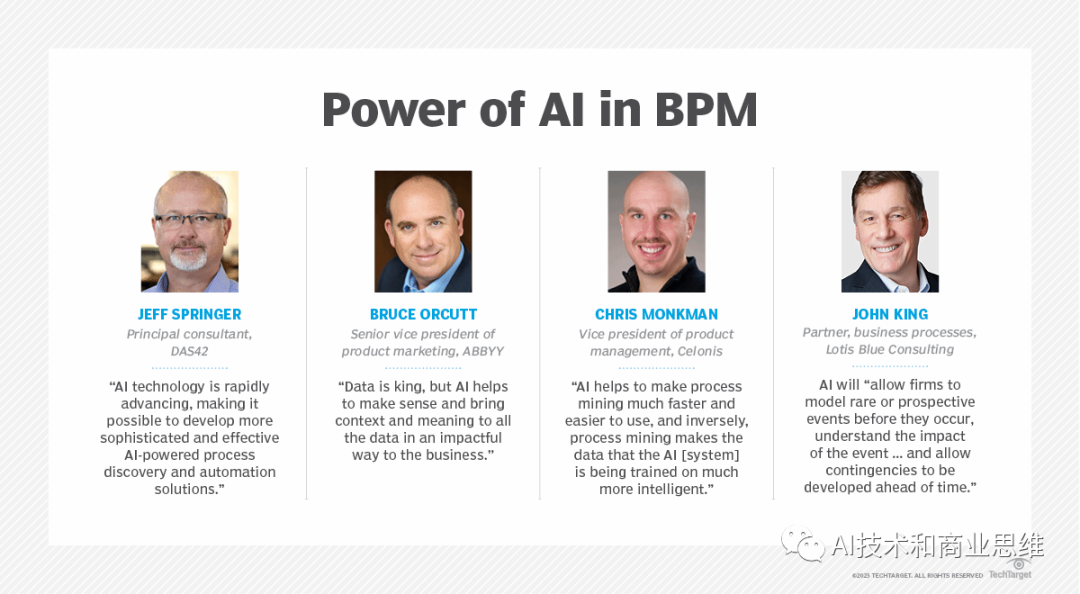 Technology peripherals
Technology peripherals
 AI
AI
 How artificial intelligence is fundamentally revolutionizing business process management
How artificial intelligence is fundamentally revolutionizing business process management
How artificial intelligence is fundamentally revolutionizing business process management
Deploying AI's discovery and automation capabilities in BPM can drive progress in front-end processes, process data analysis, business process mapping, and process modeling.

Business process management has a long history of helping enterprises with process engineering efforts and digital transformation initiatives. Now, BPM is getting a huge boost from AI
Jeff Springer, principal consultant at data and analytics consulting firm DAS42, said: "AI technology is advancing rapidly, making development more complex and more complex. Effective AI-driven process discovery and automation solutions are possible. He added that many of these advances are due to the increasing availability of data from many sources such as enterprise systems, sensors and social media, leading to larger-scale AI deployments. .For example, the development of deep learning algorithms enables artificial intelligence systems to learn from data and identify patterns that are difficult or impossible for humans to recognize.
How is AI changing BPM?
In BPM, AI-enabled deployment is becoming more and more popular. This deployment method plays an important role in many application scenarios. It can be used to optimize front-end processes, analyze process data, and map business processes, and even leverage generative AI process modeling capabilities
Front-office processes
##Gryphon, the provider of intelligent platform for call centers, has stated that the deployment of artificial intelligence in front-end processes is driving sales, improving customer satisfaction, and enhancing employee dedication. For example, in contact centers, AI in business process management enriches customer interactions, reduces call waiting time, provides personalized recommendations, and offers real-time sales assistance.
Process Mining
Process Mining is a key enabler of BPM, helping companies discover improved processes, create value and cost reduction opportunities. “Artificial intelligence helps make process mining faster and easier to use,” explains Chris Monkman, vice president of product management, artificial intelligence and knowledge at business process SaaS provider Celonis. “In contrast, process mining enables manual The data the intelligence (system) is being trained on becomes even smarter, thereby unlocking its true power. But when it comes to training large language models (LLMs) and generative AI’s battle against hallucinations, innovations in process intelligence will require improvements in real-time structured data and semantic knowledge.
Object-centric process mining
Celonis and RWTH Aachen University are combining artificial intelligence and object-centric process mining to to better understand and control business processes. For example, as real objects like shipping orders or invoices move through a business process, AI can continuously update expected delivery times, send alerts when delays occur, and even take action to resolve issues

Large Process Model
Enterprise management software company SAP Signavio is using labeled data from LLM to train a so-called Large Process Model (LPM) , to analyze process data more accurately. SAP and academic researchers have released the SAP Signavio Academic Models LPM dataset, a collection of hundreds of thousands of business models, primarily in business process modeling notation. Dee Houchen, head of global market impact at SAP Signavio, said LPM can be deployed in many use cases, such as best practice recommendations, process analysis, content creation and process data enhancement.
Data extraction and enrichment
ABBYY optical character recognition software provider ABBYY is exploring artificial intelligence technology, said Bruce Orcutt, senior vice president of product marketing at ABBYY How to extract more data from client documents and correspondence to speed up decisions on enrollment, funding and approval processes. AI can also be used to enrich data insights and improve process outcomes. “Data is king,” Orcutt said, “but AI helps make sense of all data and bring context and meaning to all data in ways that are impactful to the business.
Low-Code/No-Code Development
Traditionally, low-code and no-code tools have been combined with BPM analysis tools to help streamline business re-engineering efforts. John King, business process partner at Lotis Blue Consulting, said AI is using GitHub Copilot capabilities to enable more low-code/no-code development. This feature can promote decentralization of application development and promises faster changes and more A/B testing type deployments to meet customer needs. Enterprises can also develop and support applications that automate critical business processes with just IT department infrastructure and platform support
WORKING NETWORK ANALYSIS
Network analysis is a method of using graph theory to understand the structure and function of complex systems. King believes these same concepts can be extended to the enterprise through work network analysis, which can handle work content from meetings, phone calls, instant messages and emails. Through artificial intelligence's identification of behavioral and collaboration patterns and comparing them to company expectations and best practices, productivity can be improved when needed
digital twin
A digital twin is a working model that connects digital threads to real-world physical environments and complex processes. AI technology can help transform raw data captured from sensors and workflows into more relevant digital twins. In addition, King pointed out that artificial intelligence can also be applied to these models to provide different scenarios and decision-making analysis. He believes this will help save time and money and allow companies to model rare or expected events before they occur, thereby understanding the impact of the event in a safe but objective environment and developing contingency measures
Business Process Mapping
According to DAS42’s Springer, artificial intelligence and machine learning models are already being applied to automatically map business processes and identify areas for improvement and automation. Chance. He noted that one manufacturing company was successfully increasing output by 10% by monitoring its production lines in real time, identifying potential bottlenecks and other issues, and providing operators with corrective actions.
Business Process Analysis
Traditionally, business process analysis is done manually by process experts. Stephen Ross, head of business development for the Americas at cybersecurity consulting firm S-RM, said AI in BPM can accelerate business process analysis results for tasks involving modeling, collaboration, process mining, and risk management and compliance.
Chatbots, Virtual Assistants and NLP
Although chatbots and virtual assistants have been around for nearly 60 years, their commercial value did not exist until This has only been achieved in the last ten years. Powered by generative AI, natural language processing (NLP) opens up new business opportunities for chatbots and virtual assistants that can be integrated into BPM systems to handle queries, guide employees through processes, and improve customer interactions. NLP is also good at analyzing unstructured data sources, such as customer feedback and social media posts, to extract valuable insights.

The advantages of AI in BPM
Taking Gryphon’s Steele as an example, he pointed out that in BPM Applying artificial intelligence in China can identify opportunities to optimize processes, improve efficiency, reduce costs and create value, as follows:
- Identifies and automates repetitive tasks, freeing up call agents to focus for more complex tasks, increasing customer satisfaction.
- Route customers to the correct agent or department to reduce call wait times and ensure customers receive the best service.
- Provide real-time assistance to agents to resolve customer service issues faster and more efficiently.
- Analyze data to identify customer sentiment, trends and patterns to improve customer experience.
Challenges of Artificial Intelligence in Business Process Management
The benefits of deploying AI in BPM applications come with challenges, risks and ethical issues , including the following content starting with :
- Lack of overall overview. There is currently no consensus on how generative AI can contribute to BPM more broadly.
- Weaknesses of generative artificial intelligence. Concerns about accuracy, bias, reproducibility, data privacy, and hallucinations of LLM need to be addressed by vendor homogeneity.
- Data quality. Data used to train and operate AI systems must be clean, accurate and complete.
- New data risks. There needs to be greater scrutiny of siled AI within organizations and an understanding of where organizational data resides, what is made of it, and how it is used.
- Lack of skilled workers. Artificial intelligence and BPM require specialized skills and knowledge, which will require additional investment in professional training or hiring employees with the necessary skills.
- Afraid of jobs being replaced. Many organizations want generative AI and automation technologies to work in tandem, so they need to keep their employees in the loop and at the center of the transformation.
- Moral issue. Transparency, accountability and responsible use, as well as potential bias and illusion, are just some of the ethical considerations when applying AI to BPM.
The above is the detailed content of How artificial intelligence is fundamentally revolutionizing business process management. For more information, please follow other related articles on the PHP Chinese website!

Hot AI Tools

Undresser.AI Undress
AI-powered app for creating realistic nude photos

AI Clothes Remover
Online AI tool for removing clothes from photos.

Undress AI Tool
Undress images for free

Clothoff.io
AI clothes remover

AI Hentai Generator
Generate AI Hentai for free.

Hot Article

Hot Tools

Notepad++7.3.1
Easy-to-use and free code editor

SublimeText3 Chinese version
Chinese version, very easy to use

Zend Studio 13.0.1
Powerful PHP integrated development environment

Dreamweaver CS6
Visual web development tools

SublimeText3 Mac version
God-level code editing software (SublimeText3)

Hot Topics
 1386
1386
 52
52
 Bytedance Cutting launches SVIP super membership: 499 yuan for continuous annual subscription, providing a variety of AI functions
Jun 28, 2024 am 03:51 AM
Bytedance Cutting launches SVIP super membership: 499 yuan for continuous annual subscription, providing a variety of AI functions
Jun 28, 2024 am 03:51 AM
This site reported on June 27 that Jianying is a video editing software developed by FaceMeng Technology, a subsidiary of ByteDance. It relies on the Douyin platform and basically produces short video content for users of the platform. It is compatible with iOS, Android, and Windows. , MacOS and other operating systems. Jianying officially announced the upgrade of its membership system and launched a new SVIP, which includes a variety of AI black technologies, such as intelligent translation, intelligent highlighting, intelligent packaging, digital human synthesis, etc. In terms of price, the monthly fee for clipping SVIP is 79 yuan, the annual fee is 599 yuan (note on this site: equivalent to 49.9 yuan per month), the continuous monthly subscription is 59 yuan per month, and the continuous annual subscription is 499 yuan per year (equivalent to 41.6 yuan per month) . In addition, the cut official also stated that in order to improve the user experience, those who have subscribed to the original VIP
 Context-augmented AI coding assistant using Rag and Sem-Rag
Jun 10, 2024 am 11:08 AM
Context-augmented AI coding assistant using Rag and Sem-Rag
Jun 10, 2024 am 11:08 AM
Improve developer productivity, efficiency, and accuracy by incorporating retrieval-enhanced generation and semantic memory into AI coding assistants. Translated from EnhancingAICodingAssistantswithContextUsingRAGandSEM-RAG, author JanakiramMSV. While basic AI programming assistants are naturally helpful, they often fail to provide the most relevant and correct code suggestions because they rely on a general understanding of the software language and the most common patterns of writing software. The code generated by these coding assistants is suitable for solving the problems they are responsible for solving, but often does not conform to the coding standards, conventions and styles of the individual teams. This often results in suggestions that need to be modified or refined in order for the code to be accepted into the application
 Can fine-tuning really allow LLM to learn new things: introducing new knowledge may make the model produce more hallucinations
Jun 11, 2024 pm 03:57 PM
Can fine-tuning really allow LLM to learn new things: introducing new knowledge may make the model produce more hallucinations
Jun 11, 2024 pm 03:57 PM
Large Language Models (LLMs) are trained on huge text databases, where they acquire large amounts of real-world knowledge. This knowledge is embedded into their parameters and can then be used when needed. The knowledge of these models is "reified" at the end of training. At the end of pre-training, the model actually stops learning. Align or fine-tune the model to learn how to leverage this knowledge and respond more naturally to user questions. But sometimes model knowledge is not enough, and although the model can access external content through RAG, it is considered beneficial to adapt the model to new domains through fine-tuning. This fine-tuning is performed using input from human annotators or other LLM creations, where the model encounters additional real-world knowledge and integrates it
 Seven Cool GenAI & LLM Technical Interview Questions
Jun 07, 2024 am 10:06 AM
Seven Cool GenAI & LLM Technical Interview Questions
Jun 07, 2024 am 10:06 AM
To learn more about AIGC, please visit: 51CTOAI.x Community https://www.51cto.com/aigc/Translator|Jingyan Reviewer|Chonglou is different from the traditional question bank that can be seen everywhere on the Internet. These questions It requires thinking outside the box. Large Language Models (LLMs) are increasingly important in the fields of data science, generative artificial intelligence (GenAI), and artificial intelligence. These complex algorithms enhance human skills and drive efficiency and innovation in many industries, becoming the key for companies to remain competitive. LLM has a wide range of applications. It can be used in fields such as natural language processing, text generation, speech recognition and recommendation systems. By learning from large amounts of data, LLM is able to generate text
 Five schools of machine learning you don't know about
Jun 05, 2024 pm 08:51 PM
Five schools of machine learning you don't know about
Jun 05, 2024 pm 08:51 PM
Machine learning is an important branch of artificial intelligence that gives computers the ability to learn from data and improve their capabilities without being explicitly programmed. Machine learning has a wide range of applications in various fields, from image recognition and natural language processing to recommendation systems and fraud detection, and it is changing the way we live. There are many different methods and theories in the field of machine learning, among which the five most influential methods are called the "Five Schools of Machine Learning". The five major schools are the symbolic school, the connectionist school, the evolutionary school, the Bayesian school and the analogy school. 1. Symbolism, also known as symbolism, emphasizes the use of symbols for logical reasoning and expression of knowledge. This school of thought believes that learning is a process of reverse deduction, through existing
 To provide a new scientific and complex question answering benchmark and evaluation system for large models, UNSW, Argonne, University of Chicago and other institutions jointly launched the SciQAG framework
Jul 25, 2024 am 06:42 AM
To provide a new scientific and complex question answering benchmark and evaluation system for large models, UNSW, Argonne, University of Chicago and other institutions jointly launched the SciQAG framework
Jul 25, 2024 am 06:42 AM
Editor |ScienceAI Question Answering (QA) data set plays a vital role in promoting natural language processing (NLP) research. High-quality QA data sets can not only be used to fine-tune models, but also effectively evaluate the capabilities of large language models (LLM), especially the ability to understand and reason about scientific knowledge. Although there are currently many scientific QA data sets covering medicine, chemistry, biology and other fields, these data sets still have some shortcomings. First, the data form is relatively simple, most of which are multiple-choice questions. They are easy to evaluate, but limit the model's answer selection range and cannot fully test the model's ability to answer scientific questions. In contrast, open-ended Q&A
 SOTA performance, Xiamen multi-modal protein-ligand affinity prediction AI method, combines molecular surface information for the first time
Jul 17, 2024 pm 06:37 PM
SOTA performance, Xiamen multi-modal protein-ligand affinity prediction AI method, combines molecular surface information for the first time
Jul 17, 2024 pm 06:37 PM
Editor | KX In the field of drug research and development, accurately and effectively predicting the binding affinity of proteins and ligands is crucial for drug screening and optimization. However, current studies do not take into account the important role of molecular surface information in protein-ligand interactions. Based on this, researchers from Xiamen University proposed a novel multi-modal feature extraction (MFE) framework, which for the first time combines information on protein surface, 3D structure and sequence, and uses a cross-attention mechanism to compare different modalities. feature alignment. Experimental results demonstrate that this method achieves state-of-the-art performance in predicting protein-ligand binding affinities. Furthermore, ablation studies demonstrate the effectiveness and necessity of protein surface information and multimodal feature alignment within this framework. Related research begins with "S
 SK Hynix will display new AI-related products on August 6: 12-layer HBM3E, 321-high NAND, etc.
Aug 01, 2024 pm 09:40 PM
SK Hynix will display new AI-related products on August 6: 12-layer HBM3E, 321-high NAND, etc.
Aug 01, 2024 pm 09:40 PM
According to news from this site on August 1, SK Hynix released a blog post today (August 1), announcing that it will attend the Global Semiconductor Memory Summit FMS2024 to be held in Santa Clara, California, USA from August 6 to 8, showcasing many new technologies. generation product. Introduction to the Future Memory and Storage Summit (FutureMemoryandStorage), formerly the Flash Memory Summit (FlashMemorySummit) mainly for NAND suppliers, in the context of increasing attention to artificial intelligence technology, this year was renamed the Future Memory and Storage Summit (FutureMemoryandStorage) to invite DRAM and storage vendors and many more players. New product SK hynix launched last year



